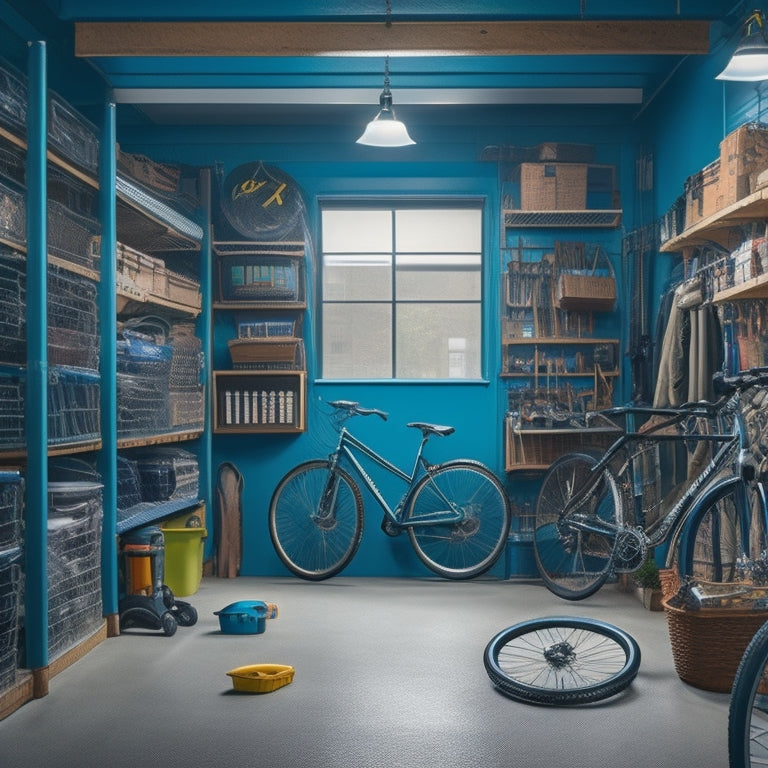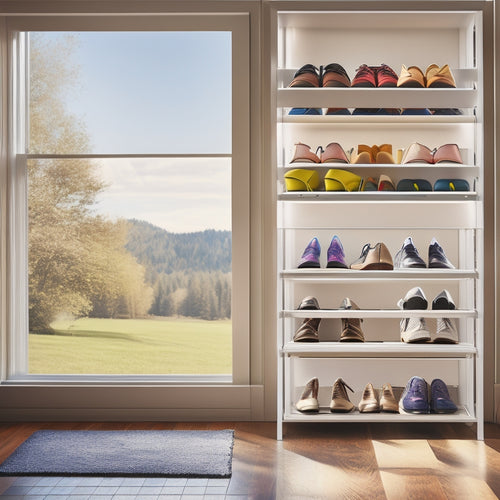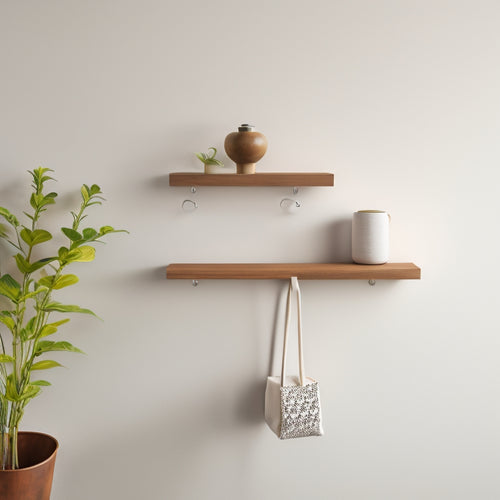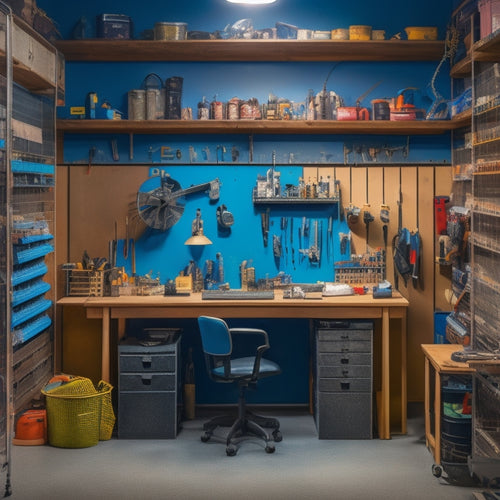
Overhead Shelves Installation Considerations
Share
When installing overhead shelves, you'll need to take into account several critical factors to guarantee a safe, functional, and compliant storage solution. Accurately measure the ceiling space, factoring in obstacles like ductwork, pipes, and lighting fixtures, and record these measurements for reference. Evaluate minimum headroom requirements, identify structural obstacles, and plan around them to avoid errors. Additionally, assess load capacity requirements, material strength, and shelf design to prevent hazards and guarantee accessibility. By carefully evaluating these considerations, you'll be well on your way to a successful installation that meets your needs and local building codes, and with further planning, you can open up a storage solution that exceeds your expectations.
Key Takeaways
- Accurate ceiling height measurement and clearance evaluation are crucial to ensure safe access and prevent hazards during overhead shelf installation.
- Structural obstacles like pipes, ducts, and electrical conduits must be identified and addressed before installation to avoid errors and ensure functional shelving.
- Load capacity requirements, including maximum weight limits and material strength, must be evaluated to ensure safety and structural integrity.
- A thorough structural integrity assessment, including testing and analysis, is necessary to certify that the shelves can withstand intended loads and comply with local building codes.
- Proper anchoring and support options, such as mechanical or adhesive anchors and reinforced shelf brackets, must be selected based on wall material and weight capacity to ensure secure installation.
Measuring the Ceiling Space
When installing overhead shelves, frequently, homeowners overlook an essential step: measuring the ceiling space. This negligence can lead to poorly fitted shelves, compromised structural integrity, and even accidents.
To avoid these issues, you must accurately measure the ceiling height to determine the maximum shelf depth and guarantee safe clearance. Measure the distance from the ceiling to the floor to determine the available space for your shelves.
Consider any obstacles, such as ductwork, pipes, or lighting fixtures, that may affect shelf placement. Record the measurements to reference later during the installation process.
Invest in the right installation tools, including a sturdy ladder, a tape measure, and a level, to guarantee accurate measurements and a secure installation.
Don't rely on estimates or rough guesses – precise measurements are essential for a safe and successful installation. By taking the time to measure your ceiling space correctly, you'll avoid potential hazards and confirm your overhead shelves are both functional and secure.
Shelves Material and Design
With your ceiling space measurements in hand, you're ready to focus on the shelves themselves, starting with the material and design.
When selecting a material, you'll want to take into account factors such as durability, weight capacity, and resistance to moisture and corrosion. Common materials for overhead shelves include steel, aluminum, and wood. Each has its own strengths and weaknesses, so it's important to choose the one that best fits your specific needs.
For instance, steel shelves offer high strength and durability, while aluminum shelves are lightweight and corrosion-resistant.
In terms of design, you'll want to take into account shelf aesthetics and design flexibility. Think about the style and finish of your shelves, as well as any custom features you may need, such as adjustable shelves or built-in lighting.
Design flexibility is also vital, as it will allow you to adapt your shelving system to changing storage needs over time.
Load Capacity Requirements
When determining the load capacity requirements for your overhead shelves, you'll need to take into account the maximum weight limits to confirm the shelves can support the intended load.
Material strength factors, such as the type of metal or wood used, will also impact the overall load capacity.
You'll need to conduct structural integrity tests to validate your calculations and assure a safe installation.
Maximum Weight Limits
Properly evaluating the maximum weight limits of your overhead shelves is essential to guaranteeing the safety of people and the integrity of your storage system.
You must consider the weight of the shelves themselves, as well as the weight of the items you plan to store on them.
When calculating the maximum weight limit, keep the following factors in mind:
-
Shelf weight distribution: Confirm that the weight is evenly distributed across the shelves to prevent uneven stress on the brackets and walls.
-
Safety margin considerations: Always add a safety margin to your calculations to account for unexpected weight additions or load shifts.
-
Load capacity of the brackets: Verify that the brackets can support the maximum weight limit you've calculated.
-
Load capacity of the walls: Ascertain that the walls can support the weight of the shelves and their contents.
-
Any local building codes or regulations: Familiarize yourself with local regulations and building codes that may impact your maximum weight limits.
Material Strength Factors
The load capacity of your overhead shelves relies heavily on the strength of the materials used in their construction. You must contemplate the shelf materials' ability to withstand the weight you plan to store, as well as the load distribution across the shelves.
When selecting shelf materials, you should prioritize those with high strength-to-weight ratios, such as industrial-grade steel or durable wood. Avoid using materials prone to warping, cracking, or corroding, as these can compromise the shelf's structural integrity. Confirm the materials can support the maximum weight you anticipate storing, considering factors like shelf size, spacing, and the weight distribution of the items you'll be storing.
Additionally, reflect on the shelf's fastening system, as it plays a critical role in maintaining load capacity. Use high-strength fasteners and anchors that can securely hold the shelves in place, even under heavy loads.
Structural Integrity Tests
How confidently can you assert that your overhead shelves will hold the weight you're planning to store?
Structural integrity tests are essential to guarantee the load capacity requirements of your shelves meet the demands of the intended use. These tests help identify potential weaknesses, material fatigue, and load distribution issues before they become safety hazards.
To verify the structural integrity of your overhead shelves, consider the following:
-
Static load testing: Apply a constant weight to the shelves to assess their ability to withstand the intended load.
-
Dynamic load testing: Simulate real-world usage by applying varying weights and frequencies to mimic the intended use.
-
Material fatigue testing: Evaluate the shelves' ability to withstand repeated stress and strain over an extended period.
-
Load distribution analysis: Assess how weight is dispersed across the shelves to identify potential hotspots and weak points.
-
Certification and compliance testing: Verify your shelves meet relevant industry standards and regulations, such as OSHA or ANSI guidelines.
Clearance and Obstruction Issues
When planning your overhead shelves installation, you'll need to evaluate clearance and obstruction issues to guarantee a safe and functional storage system.
You must determine the minimum headroom requirements to allow for easy access and retrieval of items, factoring in the height of the shelves and the tallest users.
Additionally, you'll need to identify and work around structural obstacles, such as ductwork, pipes, and electrical conduits, that could interfere with shelf placement or accessibility.
Headroom Requirements
Will you have sufficient clearance above your overhead shelves to accommodate storage bins, baskets, or other items? When planning your overhead shelves installation, it's essential to contemplate headroom requirements to guarantee both aesthetics and functionality.
You want to strike a balance between maximizing storage space and maintaining a safe, accessible area.
To determine the ideal headroom, contemplate the following factors:
-
Headroom height: Confirm the clearance above your shelves is at least 18 inches to allow for comfortable access and retrieval of stored items.
-
Storage container size: Choose bins and baskets that fit within the available headroom to avoid obstructing walkways or creating tripping hazards.
-
Overhead functionality: Think about installing shelves with adjustable heights or slide-out bins to optimize storage capacity while maintaining easy access.
-
Lighting and ventilation: Confirm sufficient clearance for lighting fixtures, air vents, or other overhead features that may impact headroom aesthetics.
-
Local building codes: Verify compliance with local regulations and building codes regarding headroom clearance and overhead storage.
Structural Obstacles
Pipe ducts, electrical conduits, and other structural elements can pose significant clearance and obstruction issues when installing overhead shelves. You must identify these obstacles before installation to avoid costly mistakes and guarantee a safe working environment.
Proper obstacle identification involves inspecting the ceiling area for any protrusions, conduits, or ducts that may interfere with your shelves. Take precise measurements to determine the available clearance and adjust your installation techniques accordingly.
When dealing with structural obstacles, you may need to modify your shelf design or adjust the installation location. For instance, you can use cantilevered shelves or offset brackets to work around obstructions.
It's crucial to consult local building codes and regulations to confirm your installation meets safety standards. Additionally, consider consulting with a professional if you're unsure about how to maneuver complex obstacle identification or installation techniques.
Lighting and Electrical Concerns
During the overhead shelves installation process, you'll inevitably encounter lighting and electrical concerns that demand attention.
As you plan and execute the installation, it's essential to take into account the lighting types and electrical safety aspects to guarantee a secure and functional setup.
When it comes to lighting, you'll need to address the following:
-
Task lighting: Confirm sufficient lighting for people working or accessing items on the shelves.
-
Ambient lighting: Provide adequate general lighting to create a comfortable and safe environment.
-
Emergency lighting: Install emergency lights or exit signs to guide people in case of a power outage or emergency.
-
Lighting fixtures: Choose fixtures that are durable, easy to clean, and resistant to moisture and corrosion.
-
Electrical load capacity: Verify that the electrical system can handle the additional load of lighting and any other electrical components.
Ventilation and Airflow Needs
As you verify the electrical system can handle the additional load, you'll also want to take into account the air quality and circulation in the area where the overhead shelves will be installed.
Proper ventilation and airflow are essential to guarantee a safe and healthy working environment. Overhead shelves can obstruct air circulation, leading to stagnant air and increased humidity. This can lead to mold growth, rust, and corrosion of equipment and shelves.
You'll need to assess the air circulation in the area and confirm it meets the recommended standards. Consider installing vents, fans, or air exchange systems to maintain a consistent airflow.
Additionally, you should implement humidity control measures to prevent moisture buildup. This may involve installing dehumidifiers or verifying the area is well-ventilated to remove excess moisture.
Structural Integrity Assessment
While installing overhead shelves, you must confirm the existing structure can support the additional weight and stress. A thorough structural integrity assessment is essential to guarantee the safety of the installation.
This assessment involves evaluating the building's design, materials, and condition to determine its capacity to handle the added load.
To conduct a shelf stability analysis, consider the following factors:
- The weight and size of the shelves, including the materials used and their density
- The type and strength of the ceiling or roof structure, including any existing loads or obstructions
- The presence of any structural weaknesses, such as cracks or water damage
- The effect of external factors, such as wind or seismic activity, on the structure
- The compliance of the installation with local building codes and regulations
Anchoring and Support Options
When installing overhead shelves, you'll need to make certain they're securely anchored to the wall to prevent collapse or damage.
You have two primary anchoring methods to choose from: mechanical anchors that screw into the wall or adhesive anchors that bond to the wall surface.
Additionally, consider using reinforced shelf brackets to provide extra support and distribute the weight of your stored items more evenly.
Wall Anchoring Methods
By the time you're ready to install your overhead shelves, you've likely given some thought to the type of shelving system you want and the materials you'll need.
However, one vital aspect that requires careful consideration is the wall anchoring method. The type of anchor you choose will depend on the wall material and the weight capacity you need.
Here are some common anchor types suitable for different wall materials:
-
Hollow-wall anchors for drywall or plaster walls, which provide a secure hold without damaging the surrounding area.
-
Molly bolts for hollow walls, offering high weight capacity and resistance to pull-out.
-
Anchor screws for solid walls, such as concrete or brick, providing a strong and reliable hold.
-
Toggle bolts for hollow walls, which expand when tightened to create a secure anchor point.
-
Sleeve anchors for walls with a thick surface layer, such as tile or stone, which provide a strong hold without damaging the surrounding material.
Remember to choose an anchor type that suits your wall material and the weight capacity of your shelves to guarantee a safe and secure installation.
Reinforced Shelf Brackets
You've selected the right anchor type for your wall material, now it's time to focus on the shelf brackets themselves.
When it comes to reinforced shelf brackets, you have several bracket types to choose from, each designed for specific load capacities and installation techniques.
For heavy-duty shelving, consider using heavy-gauge steel brackets or reinforced aluminum brackets. These can support substantial weights, making them ideal for industrial or commercial applications.
For lighter loads, medium-gauge steel or aluminum brackets may be sufficient.
When selecting a bracket type, consider the shelving material, intended use, and weight capacity. Confirm the bracket's weight rating exceeds the combined weight of the shelf and its contents.
Proper installation techniques are also vital. Always follow the manufacturer's instructions, and use the correct screws or fasteners for your wall anchor type.
Additionally, consider consulting local building codes or regulations for specific requirements on overhead shelving installations.
Fire Suppression System Impact
Installing overhead shelves near a fire suppression system demands careful consideration to avoid compromising the system's effectiveness. You must verify that your installation complies with fire safety regulations and doesn't obstruct the sprinkler system's functionality.
When planning your overhead shelves, consider the following factors:
-
Sprinkler system compatibility: Verify that your shelves won't interfere with the sprinkler heads' spray pattern or obstruct water flow in case of a fire.
-
Clearance from fire suppression pipes: Maintain a safe distance between your shelves and the fire suppression pipes to prevent damage or obstruction.
-
Heat detection and smoke sensors: Avoid installing shelves near heat detection and smoke sensors, as they may compromise their ability to detect fires.
-
Fire-resistant materials: Use fire-resistant materials for your shelves and brackets to minimize the risk of fueling a fire.
-
Emergency access: Verify that your shelves don't block emergency access routes or exit points in case of a fire.
Building Code Compliance Checks
When designing your overhead shelves, you'll need to guarantee they meet local building codes and regulations, in addition to avoiding interference with fire suppression systems. Failure to comply can result in costly rework, fines, or even facility shutdown.
You must familiarize yourself with local zoning regulations, permit requirements, and installation guidelines to ascertain your shelves meet code.
Conduct thorough research to identify applicable building permits, local ordinances, and code enforcement agencies. Obtain necessary permits and schedule safety inspections to verify compliance.
Maintain detailed compliance documentation, including design plans, material specifications, and installation records.
It's essential to collaborate with local authorities and regulatory bodies to ascertain your shelves meet all requirements. Don't assume compliance; instead, proactively address potential issues before installation.
By doing so, you'll avoid costly mistakes, guarantee a safe working environment, and maintain a positive relationship with local authorities.
Frequently Asked Questions
Can Overhead Shelves Be Installed in a Room With a Drop Ceiling?
You can install overhead shelves in a room with a drop ceiling, but you'll need to verify the drop ceiling materials can support the shelf weight limits, and that the installation won't compromise the ceiling's integrity or obstruct access to essential systems.
How Do I Handle Obstacles Like Pipes or Ductwork?
As you maneuver through the labyrinth of pipes and ductwork, imagine dodging obstacles in a high-stakes game; carefully plan pipe alignment and guarantee ductwork clearance to avoid costly mistakes, assuring a safe and secure installation that won't leave you hanging.
Are Overhead Shelves Suitable for Storing Heavy Machinery?
When storing heavy machinery, you'll need to guarantee the overhead shelves can handle the weight capacity, considering factors like shelf materials, structural integrity, and load distribution to prevent accidents and guarantee safe operations.
Can I Install Overhead Shelves in a Room With a Sloped Ceiling?
When renovating a mountain lodge, you'll encounter sloped ceilings. To install overhead shelves, you'll need to make slope adjustments, choosing shelf materials that can withstand the angle, ensuring a sturdy and secure storage solution that prioritizes safety.
Do Overhead Shelves Require Regular Maintenance or Inspections?
You'll want to regularly inspect your overhead shelves to guarantee they meet safety regulations and stay within weight limits, checking for signs of wear, rust, or damage, and making adjustments or repairs as needed to prevent accidents.
Conclusion
You've carefully maneuvered the installation considerations for overhead shelves, and now it's time to bring it all together. Think of it like building a sturdy bridge: each component, from measuring the ceiling space to evaluating structural integrity, is a vital pillar supporting the entire structure. By following these guidelines, you'll guarantee your overhead shelves are secure, functional, and compliant with building codes. The end result? A seamless and efficient storage solution that holds up to its promises.
Related Posts
-

Adjustable Modular Shoe Racks for Versatility
Adjustable modular shoe racks are your go-to solution for versatile and organized footwear storage. These racks maxim...
-

Wall Mounted Hooks With Shelf for Maximum Storage
You'll find that wall mounted hooks with a shelf are a revolutionary solution for maximizing storage in your home, pr...
-

3 Key Steps to Streamline Your Workshop Organization
You're likely wasting 30% of your workshop's productivity and profitability due to disorganization, a common problem ...


